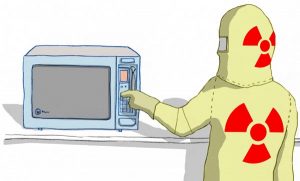
Credit: Leif Parsons
How often have you been told by your parents to stand “at least one meter” away from the microwave? These fast and convenient mini-ovens took the world by storm – or rather, by electromagnetic radiation, in the late 1980s. Now, you can barely find a home that doesn’t have one. However, even though they’ve become an essential part of the kitchen, many myths and questions about its safety still exist. Will you get radiation poisoning from standing too close when it’s on? Will it destroy every nutrient in your left-over dinner from the night before? Will it melt the plastic container and poison your food? Let us find out if your parents are just misinformed, or if they have legitimate concerns.
How do microwave ovens work?
First, here’s an overview of how a microwave oven works. As the name implies, the oven uses microwave radiation to heat up your food. Microwave radiation is electromagnetic radiation: a group of radiation that includes visible light, radio waves, microwaves, x-rays, and many more.
Video by: Bozeman Science
Microwaves are very selective. It mostly affects water by causing it to vibrate. The result of the vibrating water is a heat build-up, thus heating your food.
How does this affect us?
Now let’s bust some myths. The concern many have with standing too close to an operating microwave oven is that they’ll be exposed to the radiation, and potentially get radiation poisoning. However, every microwave oven ever produced must pass the regulation test of the Food and Drug Regulations of Canada (FDA in the U.S.) of releasing a maximum of five milliwatts of radiation per square centimeter in its lifetime, which is well under the safety limit. To put in context, a cellphone leaks 1.6 watts over its lifetime, over 300 per cent! Yet we have no problems putting those 2 inches from our faces.
So, we’re safe after all?

Metal mesh on the inside of the microwave door
Yes, microwave ovens protect your meaty flesh from heating up like the snacks we put into them. Primarily, a metal mesh lining prevents any microwaves from escaping the oven.
Furthermore, all the opening mechanisms of every microwave oven is designed to stop the flow of the microwave radiation every time we open those doors. So, for all of you that are worried you’ll grow a third arm from using the microwave so much, there’s no need to fear! This isn’t to say that you should start pressing your face against the microwave doors (because frankly, that’s a little strange), but there wouldn’t be any harm from doing it.
